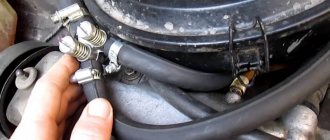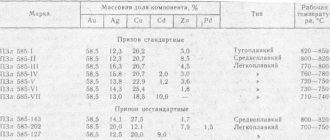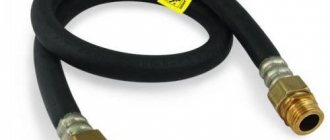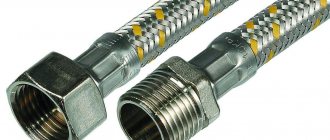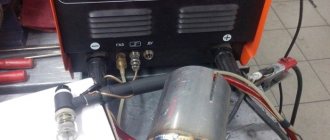SHARE ON SOCIAL NETWORKS
FacebookTwitterOkGoogle+PinterestVk
Until recently, gas household appliances were connected directly to the gas pipe. Despite the fact that the method was considered safe, it had significant disadvantages, the main one of which was the inability to move the gas stove or boiler to a convenient position. Currently, it is recommended to use flexible hoses for installation, among which the safest and most reliable is the bellows gas supply, which is a flexible corrugated hose.
Bellows hoses are the best option and are recommended for installation by gas service specialists
Main types of gas hoses: their advantages and disadvantages
Modern manufacturers offer a large selection of flexible gas hoses, which differ in material and workmanship, which affects the final cost of the finished product. You should not save on your purchase, since only a correctly selected hose will avoid problems such as gas leaks, which can lead to serious consequences. Currently, in addition to bellows hoses, manufacturers offer other types of products:
- oxygen;
The advantages of bellows samples include a long service life, reaching 25-30 years
- rubber-fabric;
- reinforced PVC rubber;
- rubber reinforced with metal braid.
Oxygen hoses are considered an obsolete option. They are rarely used in domestic conditions due to their short service life and not very attractive appearance. Most often, an oxygen hose for gas cylinders is installed if it is necessary to place the tank as far as possible from the gas stove. However, their main area of application is the transportation of gas mixtures such as butane, propane and acetylene.
The main advantages of the product include the ability to withstand high pressure up to 20 atm, ease of installation and low price. Due to the fact that the hose is rubber, it does not conduct electrical current, which reduces the likelihood of a spark.
Important! The main disadvantage of an oxygen hose is the destruction of the braid when hot oily solutions get on the surface.
A significant disadvantage of metal braided hoses is the inability to visually monitor the condition of the rubber layer.
Rubber-fabric flexible hose is the cheapest type of gas hose, which has an extremely short service life - up to 5-7 years. However, most experts are inclined to believe that it is better to change it every 3-4 years. Other disadvantages include a low level of rigidity and a small temperature range at which it is permissible to use the product - from -10 to +50 ° C. Due to its structure, the hose bends well and is characterized by a high level of electrical insulation.
A rubber hose with metal braiding has a slightly better quality, which has an optimal price-quality ratio. The product consists of special vulcanized rubber and polymer materials, which are braided on top with steel threads. The main disadvantage is the ability to become electrified, which can lead to failure of gas equipment or (even worse) to a fire. To avoid this, a dielectric bushing is used. The main advantages of rubber-fabric flexible gas line:
- low price;
- easy installation;
- Can be used at temperatures from -35 to +50 °C;
- big choice.
Rubber-fabric hoses are the most budget-friendly option for flexible hoses.
Reinforced PVC hose occupies a high position in the market due to the fact that it has a long service life (up to 12-15 years) and is designed for heavy loads - up to 0.63 MPa. The maximum length of a gas hose is 5 m, while the shortest option is only 0.4 m. Due to the fact that polyvinyl chloride is used for production, the hose does not allow electric current to pass through, bends well and is of high quality.
Selection rules
When choosing a flexible water line, not only its dimensions are important - length and diameter, so that the connection is made, if possible, without additional adapters - but also the following number of equally important factors:
- Compliance with the operating parameters of the system and the environment - temperature, pressure, location of hot objects or open flames nearby, humidity level.
- Flexibility. The higher the parameter, the easier the installation and the higher the quality of the product.
- Weight. Steel specimens are much heavier than aluminum ones. However, the latter are short-lived.
- Smell. The hose and all its components must not contain components harmful to health, emit a characteristic unpleasant odor and transfer it to water.
Bellows gas hose: main advantages
A bellows is an elastic corrugated tube that is particularly rigid. This hose is the most reliable. This type of flexible hose is recommended for installation of equipment by gas services. This is due to the fact that it is characterized not only by a high degree of safety, but also by the longest service life. In addition, it can withstand the heaviest loads created by the gas flow. Therefore, if you ask in shopping centers which gas hose is better, they will most likely offer to buy a bellows.
Helpful advice! Regardless of which flexible gas hose you decide to purchase: metal, PVC or bellows, you must take into account that it must be accompanied by a passport and certificates confirming its quality and safety of use. The minimum cross-section of the hose should not be less than 10 mm, otherwise normal operation of the gas equipment will be impossible.
Bellows hoses bend perfectly and do not change the internal diameter even with significant bending
Despite the fact that the price of a bellows gas hose is several times higher than the cost of other flexible hose options, it is still considered a leader among other types of hoses used for connecting gas stoves and boilers. The price is influenced not only by the manufacturer, but also by the length of the product, as well as the presence of additional options. Thus, some types of products are equipped with an automatic temperature sensor, which in case of violations independently cuts off the flow of gas, which can prevent leakage and fire.
Installation and maintenance features
The flexible braided water hose must be installed only in such a way that it can always be accessed during further use. This will allow you to track its current condition and, if necessary, repair or replace it. When installing, it is recommended to follow the following rules:
- Before installation, make sure there are no obvious defects in the tube.
- If it is necessary to increase the length of the line, the hose can only be extended by connecting with fittings.
- It is unacceptable to perform installation with twisting, bending, stretching and compression.
- Installation of liners through ceilings is prohibited.
- During operation, no objects should rest or hang on the hose.
To avoid leakage, the flexible line must be periodically inspected and replaced at the end of its service life.
Bellows connection for gas: what is it, main characteristics
The bellows flexible liner is a metal corrugated hose, for the manufacture of which high-quality stainless steel is used. Thanks to this feature, the hose can be stretched and its length increased. At the ends of the device there are usually 2 nuts, which are used to connect gas equipment to the fuel supply pipe, or a nut and a fitting. Stainless steel is also used in the production of fittings, which is not subject to corrosion and rust.
To connect a flexible bellows-type gas connection to the equipment and directly to the gas pipe, union nuts are used. It is mandatory to install a metal gasket made of copper or aluminum between the inlet pipe and the product - sometimes special plastic is used for this purpose.
At the ends of the hose there are two fittings, which are made of stainless steel
If you choose a bellows-type gas hose made not by European, but, for example, Chinese or Turkish manufacturers, then you should take into account that instead of stainless steel they use carbon steel, which is more brittle and more susceptible to destruction. Therefore, when purchasing a gas liner, it is recommended to give preference to products with the following markings:
- stainless steel hose: AISI 316;
- steel fitting: AISI 304 or 303.
Experts advise that when choosing a hose, be sure to check that both the fitting and the corrugation are made of the same material. This is due to the fact that each material has a certain density and strength. If different types of metal are welded together, an electrochemical reaction may occur that can destroy the welded joint, which will lead to a loss of strength of the device.
You should not purchase products where the fitting is attached to the corrugation using an adhesive mixture. You should also not buy hoses in which the fitting is soldered using tin or silver. In this case, the products will not last long, and their strength may also be called into question. Therefore, when purchasing, you should pay attention to the fact that the price of a gas hose should not be suspiciously low.
Bellows liner can withstand pressure up to 6 atmospheres
Main technical characteristics of bellows hoses for gas
Like any other product, a bellows gas hose has specific features and parameters that set it apart from other options. Among the main characteristics it is worth noting the following:
- The products can be used over a wide range of temperature changes - from -50 to + 250 °C, and at any temperature within these limits the hose does not lose its qualities.
- The maximum pressure for which the hose is designed is 6 atmospheres. It must be taken into account that according to the standards, the maximum pressure at which gas can enter residential premises is 0.03 atm. From this we can conclude that the safety margin of the product is 200%.
- Thanks to the corrugated surface, the product can be extended to 2 times its original size. This ability is ensured by the use of high-quality stainless material that has been pre-annealed.
- Long period of operation. The service life of a bellows gas hose is 20-25 years, although some manufacturers offer a 30-year warranty.
Helpful advice! Despite the fact that the product can be stretched, it is not recommended to double it: the more the hose is stretched, the more its rigidity decreases. Therefore, the maximum stretch that can be applied to the product is 50%.
Bellows hoses are equipped with a corrugated casing that protects the inner hose from damage
A very important point when choosing a bellows-type metal gas hose is the availability of a quality certificate confirming that the product is intended for use with explosive substances. The passport must indicate the fact that the product has been tested and meets all safety requirements. It is necessary to pay attention to the production time and service life of the hose.
Briefly about the main thing
The bellows tube is often made of an inner rubber and outer metal shell. There is also a pure steel corrugated model. Flexible hoses have a wide range of applications - in plumbing, heating and cooling systems, fire extinguishing equipment, drainage and gas appliances. Among its main advantages are flexibility, lightness, installation, and durability. Disadvantages: insufficient tensile strength and limited temperature.
Flexible braided water hoses are classified according to several criteria:
- Purpose.
- Features of the shell device.
- Type of braid material.
- Types of fitting material.
When choosing a liner for a specific application, not only the diameter and length are taken into account, but also its compliance with external and internal conditions, flexibility, weight and harmlessness. Installation and operation of hoses must be carried out strictly in accordance with the recommendations.
Main manufacturers of bellows gas line
The market leader in the production of bellows hoses is considered to be the Italian company Emiflex, which has also been certified in Russia. After some research, approval for the use of hoses from this company was given by the state organization Rostest. In addition, the manufacturer received the appropriate permit from Gosgortekhnadzor, which approved the use of products for connecting household gas in residential premises.
The Emiflex gas hose has the following technical characteristics, which make the company a market leader:
- the product is designed to work with natural and liquefied gas;
- the maximum gas pressure for which the product is designed is 7 atm;
- the device can be operated without loss of properties at temperatures from -20 to +100 °C;
- thickness of the metal bellows hose – 2.1 cm;
EMIFLEX is one of the world's leading manufacturers of bellows-type gas hoses.
- it is permissible to stretch the product twice its original length;
- Hoses are available in various cross-sectional diameters - 1, 1/2, 3/4 (in inches);
- Among the types of fastenings, options such as nut-nut and nut-fitting are available;
- The outer coating of the bellows protects the product from exposure to chemical detergents.
The maximum length of the Emiflex gas hose, which is certified in Europe, is 2 meters. For the production of devices, stainless steel is used, marked AISI 316 L. In addition, the hose comes with an aluminum gasket, which is used during installation. The manufacturer draws attention to the fact that lengthening the sleeve is possible only during installation. It is unacceptable to stretch the hose during operation.
Another certified Italian manufacturer in the Russian Federation is Idrosapiens SRL, which also has a European quality certificate confirming the product’s compliance with standards for household use.
The gas hose from Idrosapiens SRL has excellent technical characteristics
Gas hoses from this company guarantee high-quality and safe operation for 15 years. At the same time, longer use is not excluded, but without providing a warranty from the manufacturer. Below is a table indicating the price of gas hoses from Italian manufacturers.
| Size, inch | Length, m | Manufacturer and price, rubles | |
| Emiflex | Indrosapiens | ||
| 1/2 | 0,5 | 1350 | 1300 |
| 0,75 | 1700 | 1500 | |
| 1 | 1850 | 1650 | |
| 2 | 3800 | 3450 | |
| 3/4 | 0,5 | 1700 | 1550 |
| 0,75 | 2000 | 1750 | |
| 1 | 2500 | 2150 | |
Features of flexible bellows stainless steel gas line. 1/2 and 3/4 Belarusian manufacturer
The Belarusian company Zurflex is considered a more affordable (in terms of price) certified manufacturer of flexible hoses on the Russian market. It produces products designed for connecting gas stoves, hobs and gas equipment intended for individual heating. The Belarusian manufacturer presents a bellows connection for gas 1/2 and 3/4 with a nut-nut connection option (one has an internal thread, and the other has an external thread) or a nut-fitting. The temperature at which it is permissible to use the product varies in the range from – 15 to + 150 °C. Other product parameters:
- recommended operating pressure is 30 atm., and maximum is 100 atm.;
Related article:
Gas hose for gas stove: the right choice that guarantees safety
Main types of products, their advantages and disadvantages. Expert advice on hose selection. Features of secure connection.
- the minimum bending radius that can be created manually is 45 mm;
- the inner diameter of the sleeve is 12 mm, the outer diameter excluding coating is 17 mm;
- Stainless steel grade A151 3041 is used in production;
- steel corrugation thickness – 0.15 mm;
- the maximum length of the gas hose is 5 meters;
- guaranteed service life – 15 years.
The most commonly used diameters of bellows liner are 1/2 or 3/4 inches
It should be taken into account that the end fittings and union nuts from this manufacturer are made of carbon steel, but thanks to the chrome-nickel coating, the elements have good strength indicators. Ease of use and installation of Zurflex products is ensured by the presence of a paronite or aluminum gasket in the kit. The quality guarantee is confirmed by the technical passport and identification sticker located on the front of the package. Prices for Zurflex hoses are presented in the table below.
| Size, inch | Length, m | Price, rubles |
| 1/2 | 3 | 750 |
| 4 | 950 | |
| 5 | 1200 | |
| 3/4 | 2 | 900 |
| 2,5 | 1100 | |
| 3 | 1200 |
How to distinguish a flexible stainless steel gas connection from a fake: selection rules
Due to the popularity of bellows-type gas hoses, there are often counterfeits on the markets, most often coming from China. At the same time, one should not confuse Chinese products manufactured at the request of European companies in compliance with technical standards and regulations, and low-quality fakes.
Helpful advice! Many European companies, in order to reduce the cost of the finished product, officially place orders with Chinese factories that produce products that meet quality standards. Such hoses have the necessary certificates and are considered reliable and safe.
The second category of Chinese bellows hoses for gas stoves includes products produced by pirate methods without complying with technical standards and using low-quality materials. Hoses that are manufactured using handicraft methods are of low quality, which reduces the level of safety of the products. Such hoses often become the cause of gas leaks and the source of many other troubles. It is also necessary to take into account the fact that even products of dubious quality can have a high price. Therefore, when purchasing, you should adhere to the following rules:
- select products only from certified retail outlets;
The elastic eyeliner will not sag, which indicates the proper quality of the product.
- pay attention to certificates and hose passports;
- do not buy hoses from a seller who refuses to show product documentation;
- carry out a visual inspection of the product before purchasing;
- If there are any defects or damage to integrity, the product should be rejected.
You definitely need to know that gas stoves are connected only using a hose, which is characterized by the presence of a yellow mark. The presence of red or blue markings indicates that the product is intended for sanitary use. It is important to select the correct bellows hose size. To do this, you need to measure the distance from the gas pipe to the connected equipment. The sleeve should not sag too much or be under tension. Splicing several hoses together is strictly prohibited.
When purchasing, you need to pay attention to the mounting method (fitting or nut) and choose the right size. If this is a 1/2 bellows gas supply, then the fastening must correspond to this parameter. If the stove has electric ignition, you need to purchase a safe flexible hose with an insulator, which is white plastic rings located between the nuts and the braid, or you should additionally install a dielectric insert.
There are certain criteria for choosing a high-quality flexible liner based on the tasks assigned to this element
How to make an order
To purchase our products, you just need to select the product you like and add it to the “Cart”, and then go to the appropriate section of the site to place an order. Our store organizes delivery to all cities. A courier service operates in Moscow, St. Petersburg and Nizhny Novgorod; in other settlements, goods are delivered using transport companies. You can read more about the conditions in the corresponding section. Payment is accepted both in cash when using a courier service, and by bank transfer.
If you still have any questions, you can ask them by contacting our specialists by phone listed at the top of the page or by email.
What is a dielectric insert for gas: main purpose
The dielectric insert (coupling) is a cut-off fitting that prevents failure of gas equipment, which can be caused by stray current. These currents are formed in the ground due to a violation of the integrity of a household or industrial electrical line. In addition, their source is a railway or tram line. Stray current enters the gas pipeline due to the difference between the resistance of the soil and the metal parts that make up the gas pipeline. It is through the main line that the current enters the household gas pipeline.
Another reason for the occurrence of stray current in the gas system may be poor-quality grounding of household appliances that come into contact with the gas pipe. In general, we can say that there are many reasons for the appearance of stray currents, and the consequences from them will only be negative. To avoid this problem, a dielectric is used for the gas hose, which is inserted between the gas tap and the bellows connection to the gas appliance.
The coupling is installed in order, firstly, to prevent failure of gas equipment, especially if it is modern equipment equipped with a large number of electrical functions. Secondly, the presence of a dielectric prevents the occurrence of a spark, which can cause a fire or even an explosion. For these reasons, according to the rules of the gas service, a dielectric must be used to connect gas equipment, be it a bellows or rubber liner. It comes in two types:
- dielectric couplings - attached between the gas pipeline and the hose that fits the device;
The thread of the fitting can be cut both outside and inside the end part
- dielectric bushings - are non-conducting bushings mounted in the place of dismountable mating of gas pipe elements.
Like bellows hoses, inserts are classified by size, which vary depending on the diameter of the threaded part - 1/2, 3/4 and 1. Therefore, for any type of flexible bellows gas line, you can select a product of the appropriate size. The thread of the insert can be either external or internal. Both bushings and couplings have the same strength characteristics and are designed for a pressure of 6 atmospheres.
Interesting information! The dielectric material used in the production process of the bushing is polyamide, a non-flammable polymer characterized by a significant resistance of approximately 5 million ohms.
Dielectric couplings are special fittings with threaded ends, mounted between the gas pipeline and the fuel-consuming device.
How to properly install the dielectric when making bellows connections
According to the state safety standard, a dielectric insert must be installed between the gas tap and the bellows connection. Basic steps to be taken when installing the bushing:
- Turn off the gas valve. It is important to leave the gas on the stove so that it all burns out.
- Take 2 adjustable wrenches: with one you need to hold the valve body, and with the second, you need to tighten the nut of the bellows connection that connects the pipe to the gas appliance.
- Screw any seal onto the free ends of the coupling (a polymer version is best for this), and then manually screw the dielectric into the gas pipeline.
- Again, using 2 keys, one of which holds the valve, and the second holds the coupling, the product is screwed in until it stops. It is important not to overdo it here, so as not to strip the threads and deform the valve body.
- Screw the nut from the bellows hose onto the other end of the coupling, holding the dielectric with an adjustable wrench, and tighten the connection firmly.
After completing all the steps, you need to check the joint for leaks. To do this, use either a small brush or a shaving brush, which is first lathered generously. A soap solution is applied to all joints and inlets, after which the gas tap is slowly opened. If even small bubbles or foam suddenly appear, the tap should be turned off and the quality of the joints should be additionally checked. You can use a gas appliance only if the soap solution does not bubble. Neither matches nor lighters should be used to check leaks, as in the event of a leak they can cause a tragedy.
Any sealant must be applied to the free ends of the dielectric coupling
How to make a safe gas connection: connection features and safety precautions
Regardless of which hose for the gas stove is chosen: bellows or any other flexible hose option, the connection will be made according to the same pattern. Before connecting the hose, you need to unfold the gas device and inspect the back wall of the product. On some models, the gas pipe is marked “Output”. Depending on the configuration, the product must be placed straight or at a slight angle.
In any case, it is important that the hose does not bend too much. To avoid this, additionally purchase corner adapters that allow you to change the angle of direction of the sleeve. In advance, before carrying out all work, it is necessary to think about the location of the stove and calculate the length of the hose.
Important! Before starting work on installing or replacing a gas hose, you must turn off the gas valve and do not open it until measures have been taken to identify a possible leak.
The riser is most often located in one of the corners of the kitchen, and a pipe extends from it, connected by welding, with a gas tap attached to it, to which a flexible bellows gas supply will be attached. If the faucet has an external thread, then a union nut is used to connect the hose. If there is an internal thread, the sleeve is screwed directly into it.
Before you begin work on installing the gas supply, you must turn off the gas valve.
It is imperative to install a paronite gasket between the entrance to the gas equipment and the hose, which comes complete with the tap. Some experts recommend purchasing a gasket equipped with a metal mesh yourself. If a high-quality faucet has been chosen, then you can be sure of the reliability of the gasket.
After installing the paronite gasket, the bellows hose is screwed to the outlet of the plate, and then all connections are tightened using a wrench. At the last stage, it is necessary to conduct an inspection for the possible presence of leaks, using a soap solution, as in the case of installing a dielectric. If no bubbles appear, the cooker or other device can be used safely.

